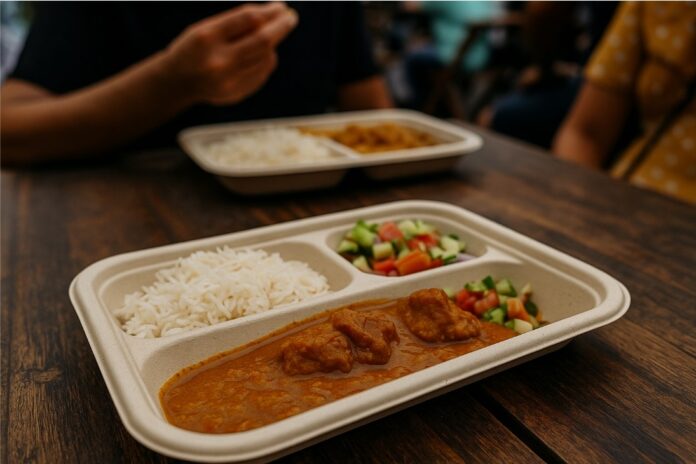Can we serve curry on this without it leaking?” asked a food vendor in Mumbai as she unpacked a box of eco-friendly plates. The answer used to be no—styrofoam or plastic were the only safe bets. But today, compostable and bagasse-based plates are redefining what’s possible in street food stalls, restaurants, and homes alike.
This shift isn’t just about aesthetics. It’s about solving real problems: waste overflow, food safety concerns, and rising regulations. Let’s dive into how compostable tableware—driven by innovators like Bioleader—is transforming the way we eat.
Plates Compost: Closing the Waste Loop
Traditional disposables end up in landfills, where they take centuries to degrade. The European Environment Agency (2024) confirmed that single-use plastics account for over 40% of Europe’s coastal litter.
That’s why plates compost are gaining traction. These plates fully break down within 90 days in industrial composting, turning into nutrient-rich soil instead of toxic waste.
Case Study: A Barcelona street festival replaced 200,000 plastic plates with compostable alternatives in 2024. Waste audits showed a 61% landfill diversion rate, while composted waste went to enrich urban gardens.
Plate Made from Bagasse: Turning Agricultural Waste into Assets
Bagasse, the fibrous residue of sugarcane, used to be burned or discarded. Now, it’s being molded into durable dinnerware.
Plate made from bagasse products are not only strong enough for oily foods but also reduce carbon emissions. According to a Journal of Industrial Ecology (2023) study, bagasse plates have a 29% lower carbon footprint compared to PET plastic plates.
Example: In Thailand, a catering company shifted 80% of its serviceware to bagasse plates in 2024, reducing annual CO₂ emissions by 14 tons. Customers praised the natural look, saying it matched the authenticity of traditional Thai cuisine.
Three Compartment Plates: Solving Portion and Waste Challenges
One major pain point in street food is portioning—mixing rice, curry, and salad on the same plate can lead to soggy messes. Three compartment plates solve this problem with functional design.
Consumer Insight: A 2025 survey by NielsenIQ found that 73% of urban diners prefer compartment plates at events and takeaways, citing cleanliness and convenience.
In Delhi, a food truck park adopted compostable compartment plates and saw food waste reduced by 17%, since diners finished more of their meals when flavors didn’t mix unnecessarily.
3 Compartment Plate: Scaling Street Food Operations
For larger vendors and canteens, the 3 compartment plate offers a standardized, scalable solution. Lightweight and stackable, it allows vendors to streamline serving while still supporting eco-friendly goals.
Case Study: In Jakarta, school canteens using 3-compartment plates reported faster serving times (cutting 14% off peak lunch hours) while aligning with the government’s 2025 single-use plastic reduction program. Parents surveyed said they trusted the school more for prioritizing eco-safe tableware.
Bagasse Plates: A Blend of Durability and Culture
Cultural events often involve heavy, sauce-rich foods that demand sturdiness. Bagasse plates provide that balance of performance and sustainability.
In Mexico City, street taco vendors adopted bagasse plates after local bans on styrofoam. Vendors reported that while unit prices were 12% higher, repeat business rose by 19% as eco-conscious millennials preferred stalls using sustainable packaging.
Scientific Support: The Ellen MacArthur Foundation (2023) listed bagasse as a “critical biomaterial” for the circular economy, combining durability with rapid biodegradation.
Bioleader’s Contribution to the Global Market
Bioleader has become a trusted name in compostable food packaging. Its strengths include:
- Certifications: EN13432, ASTM D6400, FDA, BPI, TÜV Austria.
- Diverse catalog: Compostable plates, bagasse bowls, kraft containers, PLA cups.
- Global reach: Supplying to 60+ countries across Asia, Europe, and the Americas.
- OEM/ODM flexibility: Customized printing and design for branding.
Industry publications describe Bioleader as “a bridge between food heritage and modern sustainability goals.”
FAQ
- What are the benefits of compostable plates?
They decompose quickly in industrial compost, reducing landfill waste and supporting circular food systems. - Are bagasse plates safe for hot or oily food?
Yes. Bagasse plates resist heat and grease, making them ideal for curries, tacos, or fried foods. - Why are compartment plates useful?
They separate portions, reduce cross-flavor mixing, and help manage food waste more effectively. - Do compostable plates cost more than plastic?
Typically 10–20% more per unit, but vendors save on waste management and boost customer loyalty. - What makes Bioleader a trusted supplier?
Global certifications, product diversity, and proven ability to scale eco packaging solutions.
Conclusion: Plates That Do More Than Serve Food
The Mumbai vendor’s question—“Can we serve curry on this without it leaking?”—has a clear answer today: yes. With plates compost, plate made from bagasse, three compartment plates, 3 compartment plates, and bagasse plates, food vendors and households alike can solve the pain points of waste, safety, and compliance.
This is more than packaging. It’s a statement of values, a way to align food culture with sustainability. And with Bioleader at the forefront, the future of dining looks not just delicious, but responsible.

